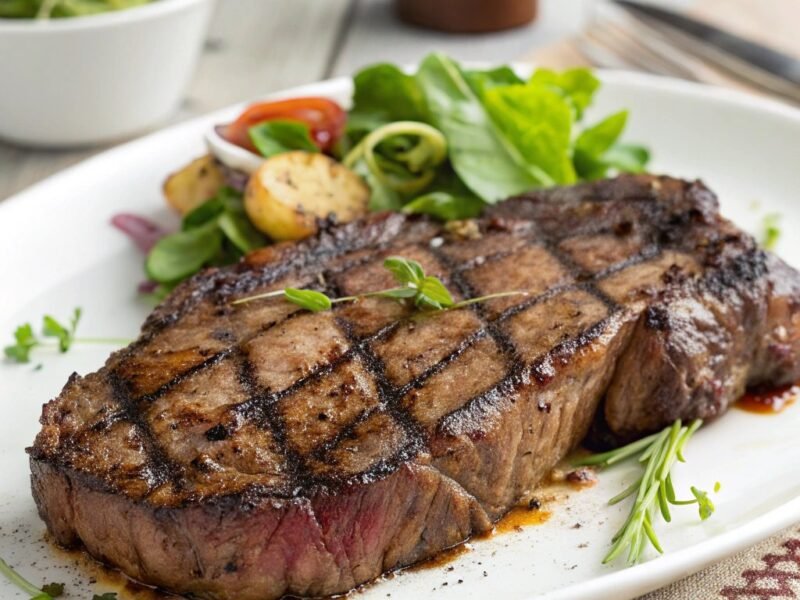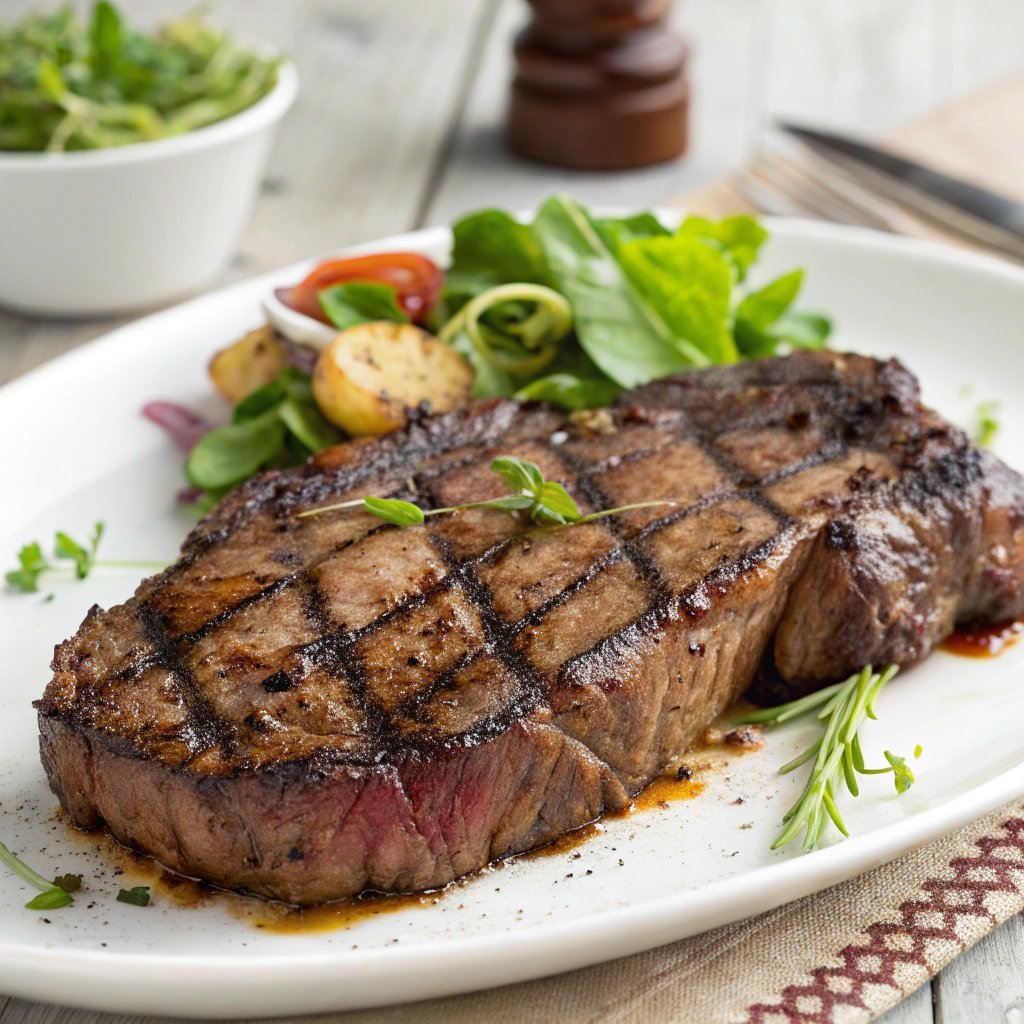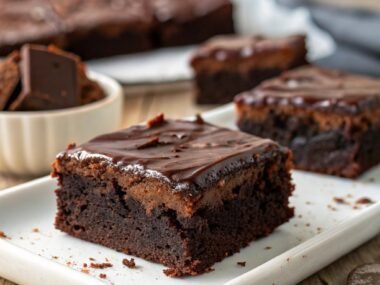Let’s Talk Father’s Day Steak, Shall We?
Okay, so Father’s Day. What does it mean? Well, for me, it usually means sunshine (fingers crossed!), the smell of charcoal, and my dad kicking back with a cold one while I man the grill. Honestly, he taught me most of what I know about grilling, probably starting with burgers that were either hockey pucks or still mooing. We’ve come a long way! And the go-to celebratory meal? A perfectly grilled ribeye steak. It just feels right, you know? It’s simple, it’s impressive, and who doesn’t love a good steak? This is how we celebrate Fathers Day with grilled ribeye steak in my house, it’s pretty foolproof.
Why This Grilled Ribeye Thing Works Every Time
Right, why this recipe? Well, mostly because it’s ridiculously easy but looks like you’ve made a massive effort (win win!). My family goes absolutely bonkers for a good steak, and ribeyes? They’ve got that beautiful marbling that just melts on the grill, making them super forgiving even if you get distracted chasing a rogue football form the garden. It’s my go-to for any special occasion grilling, especially Father’s Day. Plus, cleanup is minimal which is always a bonus, right?! Less time scrubbing, more time sipping that beer alongside Dad.
What You’ll Need (The Shopping List Bit)
- Ribeye Steaks: Obvs. Get good ones, about 1 to 1.5 inches thick. Look for nice fat marbling – that’s where the flavour lives! Usually grab two hefty ones.
- Olive Oil: Just a drizzle to help the seasoning stick. Any kind works, don’t stress.
- Coarse Salt: Kosher salt or sea salt flakes are ace. Makes a nice crust.
- Black Pepper: Freshly cracked if you can be bothered, it really does make a difference. A decent amount!
- Garlic Powder (Optional, but good!): I sometimes add a sprinkle, sometimes I don’t. Depends on my mood. Fresh garlic can burn easily on the grill, so powder is safer here.
- Butter (Optional, for finishing): A knob of unsalted butter melted on top at the end? *Chef’s kiss*. Sometimes I mix in some herbs like rosemary or thyme if I’m feeling fancy. My nan swore by adding a tiny bit of Worcestershire sauce to the butter, but shh, that’s a family secret.
Okay, Let’s Get Grilling!
- Prep the Steaks: Take the steaks out of the fridge a good 30 minutes before you plan to grill. Let them chill out on the counter – helps them cook more evenly. Pat them super dry with paper towels. Like, really dry. This helps get that gorgeous sear.
- Season Generously: Drizzle with a bit of olive oil, then go wild with the salt, pepper, and garlic powder if you’re using it. Be more generous than you think you need to be, especially with the salt. Get all the sides and edges.
- Get That Grill HOT: Whether you’re using charcoal or gas, you want a hot zone and a cooler zone. For charcoal, bank the coals to one side. For gas, crank up half the burners high and leave the others low or off. You’re aiming for around 450-500°F (230-260°C) on the hot side. Let it preheat properly! I once tried rushing this step and regretted it because the steaks just sort of… steamed. Not good.
- Sear ‘Em High: Place those beautiful steaks directly over the high heat. You should hear a satisfying SIZZLE! Sear for about 2-4 minutes per side, until you get lovely grill marks and a deep brown crust. Don’t fiddle with them too much during searing! Let the heat do its thing. This is where I usually sneak a look underneath after a minute or two.
- Move to Indirect Heat (The Magic Step): Once seared, move the steaks over to the cooler side of the grill. This lets them cook through gently without burning the outside. Close the lid.
- Cook to Perfection (Use a Thermometer!): This is where a meat thermometer is your best friend. Seriously. It takes the guesswork out. Cook until it reaches your desired doneness. I pull mine off a few degrees *before* the target temp, as they’ll keep cooking while resting. Here’s a rough guide:
- Rare: 125-130°F (52-54°C)
- Medium-Rare: 130-135°F (54-57°C) – My personal sweet spot!
- Medium: 135-140°F (57-60°C)
- Medium-Well: 140-145°F (60-63°C)
- Well-Done: 160°F+ (71°C+) (Though, please don’t do this to a lovely ribeye!)
You can find super accurate guides on sites like AmazingRibs.com, they know their stuff.
- Butter ‘Em Up (Optional): If using, pop that knob of butter on top of each steak during the last minute or two of cooking on the indirect heat side. Let it melt all over. Mmm.
- REST! I Mean It!: This is CRUCIAL. Absolutely non-negotiable. Transfer the steaks to a cutting board or platter, tent loosely with foil, and let them rest for at least 5-10 minutes. Seriously, 10 is better. This lets the juices redistribute throughout the meat. If you slice too soon, all that lovely flavour just pools out onto the board. Tragic!
- Slice and Serve: Slice the steak against the grain. Serve immediately and soak up the compliments!
My Little Notes and Discoveries
Learned the hard way not to press down on the steaks with the spatula – squeezes out the good stuff. Also, don’t be afraid of the salt! A thick steak needs it. Oh, and flare-ups happen, especially with fatty ribeyes. Keep a spray bottle of water handy for emergencies, or just move the steak to the cool zone for a sec till things calm down.
Ways to Mix It Up (Experiments!)
Sometimes I’ll make a quick herb butter with parsley, chives, and garlic to melt on top – always a crowd-pleaser. Tried a coffee rub once… it was *interesting*. Not bad, but maybe not for Father’s Day classic vibes? Also attempted a balsamic glaze once, but it got a bit sticky and burnt easily on the high heat, wouldn’t recommend that one for this method. Stick with the simple stuff, it works!
Stuff You Might Need
A grill, obviously! Tongs are essential (don’t use a fork, it pierces the meat!). A good instant-read meat thermometer is honestly worth its weight in gold – I love my Thermapen, but any reliable one will do. If you don’t have one… well, you can try the ‘poke test’ (google it) but it’s nowhere near as accurate. Highly recommend getting a thermometer; it really ups your grilling game.

Storing Leftovers (If Any!)
Ha, leftovers! Good one. Okay, *if* by some miracle you have leftovers, let them cool completely, then wrap tightly in foil or pop in an airtight container. They’ll keep in the fridge for maybe 2-3 days? Though honestly, in my house, leftover steak rarely sees the next day. It usually becomes amazing steak sandwiches or gets sliced cold over a salad for lunch. I actually think its sometimes better the next day, sliced thin!
How We Serve It Up
We’re pretty traditional. This grilled ribeye always gets served with classic BBQ sides: creamy potato salad (my Mum’s recipe, naturally), corn on the cob dripping with butter, maybe a simple green salad. And a cold beer or a nice glass of red wine for Dad. Proper summer feasting.
Pro Tips (Learned From Mistakes!)
- Don’t overcrowd the grill: Give the steaks space! If you cram too many on, the grill temp drops and they steam instead of sear. Leave room for air to circulate.
- Know your grill’s hot spots: Every grill is different. Spend some time figuring out where yours gets hottest and coolest.
- Clean your grill grates: Seriously, scrub ’em clean before you start. Helps prevent sticking and gives you better grill marks.
- Resting isn’t optional: I know I said it before, but it bears repeating. I once skipped the rest because we were starving… big mistake. Juicy steak needs its naptime.
Quick FAQs (Stuff People Ask Me)
Can I marinate the ribeye?
You *can*, but honestly, with a good quality ribeye, you don’t need to! The flavour comes form the meat and that beautiful marbling. A simple salt and pepper rub lets the beef shine. If you really want to, a simple garlic and herb oil marinade for maybe 30 mins is okay, but avoid acidic ones for too long, they can make the texture a bit weird.
Gas or charcoal?
Ah, the eternal debate! Both work great. Charcoal gives that classic smoky flavour which I personally love, but gas is often easier to control temperature-wise. Use what you’ve got and what you’re comfortable with!
How do I know when it’s *really* done without a thermometer?
Okay, if you absolutely MUST go without a thermometer (get one!), there’s the touch test. Generally, touch the fleshy part of your palm below your thumb: open palm feels like rare, touch thumb to index finger for medium-rare, thumb to middle for medium, etc. It takes practice though, and it’s not super reliable. Really, just get a thermometer. 😉
Help! My steak is tough!
Couple of reasons this might happen: overcooking is the main culprit, especially with leaner cuts (though ribeye is usually forgiving). Slicing *with* the grain instead of against it can also make it seem tougher. And finally, not letting it rest! See? Resting is key!







